Related Research Articles

Leptictidium is an extinct genus of small mammals that were likely bipedal. Comprising eight species, they resembled today's bilbies, bandicoots, and elephant shrews. They are especially interesting for their combination of characteristics typical of primitive eutherians with highly specialized adaptations, such as powerful hind legs and a long tail which aided in locomotion. They were omnivorous, their diet a combination of insects, lizards and small mammals. One of the first branches to split from basal eutherians, they appeared in the Lower Eocene, a time of warm temperatures and high humidity, roughly fifty million years ago. Although they were widespread throughout Europe, they became extinct around thirty-five million years ago with no descendants, probably because they were adapted to live in forest ecosystems and were unable to adapt to the open plains of the Oligocene.

Heinrich Karl Eckard Helmuth von Maltzan, also known as Heinrich Eckhard Carl Helmuth von Maltzan and by his title Baron of Wartenburg and Penzlin, was a German traveller.

Eduard von Martens also known as Carl or Karl Eduard von Martens, was a German zoologist.
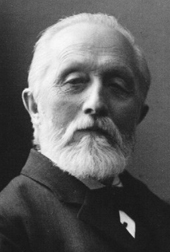
Theodor Becker was a Danish-born German civil engineer and entomologist primarily known for studies on the taxonomy of flies.
Georg Hermann Alexander Ochs was a German entomologist, specialising in Coleoptera and in particular the Gyrinidae. In this group he worked on the world fauna.

Per Olof Christopher Aurivillius was a Swedish entomologist.

Spirorbis is a genus of very small polychaete worms, usually with a white coiled shell. Members of the genus live in the lower littoral and sublittoral zones of rocky shores. Spirorbis worms usually live attached to seaweeds, but some species live directly on rocks, shells or other hard substrates. Spirorbis was once thought to have a fossil record extending back into the Early Paleozoic, but now all pre-Cretaceous spirorbins are known to be microconchids. The earliest members of genus appeared in the Miocene, but Oligocene finds may also be possible. The genus contains the following species:
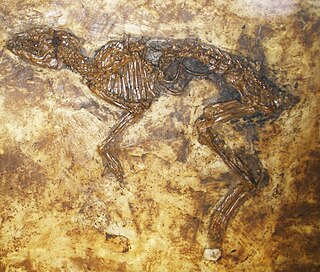
Messelobunodon is an extinct genus of early even-toed ungulate.
Paleontology or palaeontology is the study of prehistoric life forms on Earth through the examination of plant and animal fossils. This includes the study of body fossils, tracks (ichnites), burrows, cast-off parts, fossilised feces (coprolites), palynomorphs and chemical residues. Because humans have encountered fossils for millennia, paleontology has a long history both before and after becoming formalized as a science. This article records significant discoveries and events related to paleontology that occurred or were published in the year 1998.
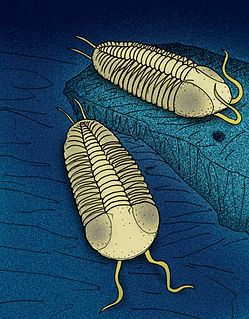
Afrops larvifer is a phacopid trilobite which lived in a marine environment during the Pragian stage in what is now southwestern Algeria. The holotype and only known specimen is an incomplete cephalon that was described by G. Alberti in 1983.
Boeckops is a genus of trilobites in the order Phacopida, which existed in what is now the Czech Republic. It was described by Chlupac in 1972, and the type species is Boeckops boecki, which was originally described as Phacops boecki by Hawle and Corda in 1847. Boeckops is also been discriped from the lower Devonian of Morocco and Algeria. The Genus Boeckops is interpreted as intermediate from between the traditional genus concept of Phacops and Reedops. The Genus Boeckops is regarded as problematic or difficult by McKellar et Chatterton 2009.

Marocella is a conical shelly fossil of uncertain affinity known from Cambrian strata of Europe, Morocco, Australia and Antarctica.
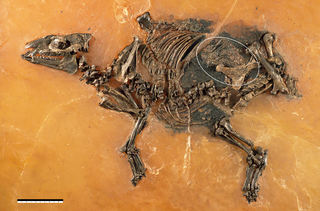
Eurohippus is an extinct genus of equid ungulate. Its species were long considered part of Propalaeotherium and Lophiotherium. A pregnant specimen was described in 2015.
Alfred Eisenack was a German paleontologist. He was a pioneer of micropaleontology and palynology. His botanical and mycological author abbreviation is "Eisenack".
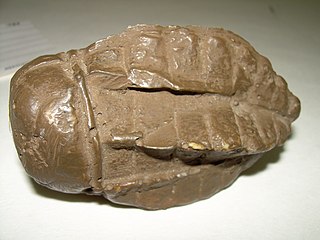
Cupressocrinitidae is an extinct family of crinoid from the Middle to Late Devonian. Cupressocrinites is a representative of this family.
Charles Le Doux was a German entomologist.
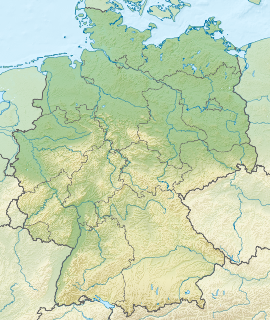
The Ahbach Formation is a geologic formation in Germany. It preserves fossils dating back to the Middle Devonian period.

The Röt Formation or Rötton Formation is a geologic formation of the Buntsandstein in Germany. It preserves fossils dating back to the Middle Triassic period. The formation overlies the Plattenstein and Solling Formations and is overlain by the Jena Formation.
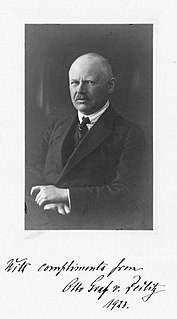
Count Otto Eduard von Zedlitz und Trützschler was a German nobleman, naturalist, explorer and writer. He settled in to Tofhult, Sweden after World War I.
References
- ↑ Devonskie tentakulity, novakii i stylioliny tsentralnoy chasti Russkoi Platformy. GP Ljaschenko, Akademija Nauk SSSR, 1-18, 1955
- Daten zur stratigraphischen Verbreitung der Nowakiidae (Dacryoconarida) im Devon von NW-Afrika (Marokko, Algerien). GKB Alberti, Senckenbergiana lethaea, 1981
- Unterdevonische Nowakiidae (Dacryoconarida) aus dem Rheinischen Schiefergebirge, aus Oberfranken und aus N-Afrika (Algerien, Marokko). GKB Alberti, Senckenbergiana lethaea, 1983
- Nowakiidae (Dacryoconarida) aus dem Hunsrückschiefer von Bundenbach (Rheinisches Schiefergebirge). GKB Alberti, Senckenbergiana lethaea, 1982